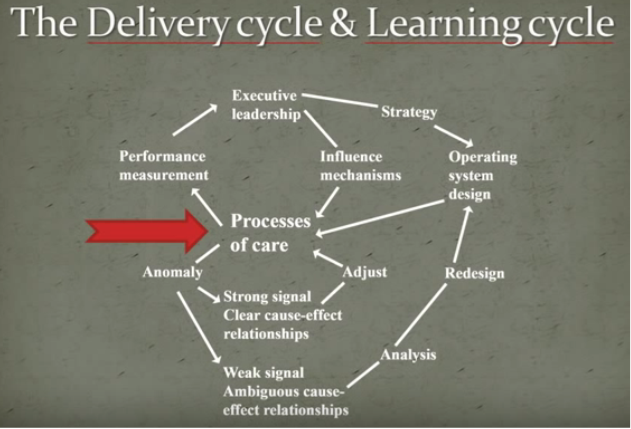
“Many of the proposals for improving the quality and curbing the rising costs of health care call for radically changing either the players or the rules governing them. Those approaches won’t work. Regardless of what happens to reform efforts, the only realistic hope is for existing general hospitals, clinics, and physician practices to redesign themselves … No single organizational design will fit all, but there are common design principles. Organizations should configure themselves to excel at three tasks: applying scientifically established best practices for treating well-understood diseases, using trial and error to deal with conditions that are complicated or poorly understood, and capturing and applying learning generated by day-to-day care [emphasis added] …” (https://thearctraining.files.wordpress.com/2013/10/r1004d-pdf-eng.pdf, p. 1/8//2/9)
The foregoing quote from the Harvard Business Review (HBR) article by Richard M. J. Bohmer, MBChB, MPH, entitled Fixing Health Care on the Front Lines is itself a partial abstract of a book by the same author (Bohmer RMJ. Designing Care – Aligning the Nature and Management of Health Care. Harvard Business Press (Boston, MA, 2009), pp. 105-107, 128-133). Both publications identify process redesign, rather than “… radically changing either the players or the rules governing them …,” as the key to healthcare/medical cost containment and quality improvement. Dr. Bohmer sketches the history of medical practice and healthcare delivery as an evolution from “… a cottage industry of autonomous artisans [physicians]” … in which the hospital served as “the doctor’s workshop” to an industry characterized by scientific advances and knowledge accrual that “… has far outstripped the ability of [healthcare] delivery organizations to apply it …;” which, he asserts, explains “… why care known to be beneficial is not consistently administered, care of uncertain value is overprescribed, and avoidable harm abounds.” To rectify this reality, Dr. Bohmer recommends that healthcare providers “redesign” their tools and methods as follows:
“What does ‘redesign’ mean? Revamping core clinical processes and the organizational structures, management systems, and cultures support them so that health care providers excel at performing three discrete tasks simultaneously:
- Rigorously applying scientifically establishes best practices for diagnosing and treating diseases that are well understood
- Using a trial-and-error process to deal with conditions that are complicated or poorly understood
- Capturing and applying the knowledge generated by day-to-day care.”
Finally, Dr. Bohmer posits “four component principles” on which the recommended redesigns should be based; which are listed below, together with a description of how an information technology (IT) solution compatible with the Cloud Healthcare Appliance Real-Time Solution as a Service (CHARTSaaS) and its reference architecture (RA) would implement each of them
- “Manage the Care: … the decisions, tasks, and workflows crucial to optimizing patient care must be the organization’s primary focus.” A CHARTSaaS RA-compliant IT solution will enable healthcare provider SMEs with minimal cost and complexity (i.e. — no software coding expertise and only minimal IT staff assistance required) to design, develop and deploy decision-based process applications a.k.a. “apps” that operate continuously, are automatically archived by version. Therefore, that will facilitate continuous process improvement (CPI) generally and also specifically The Joint Commission’s registered trademarked methodology named Robust Process Improvement a.k.a. “RPI” (http://www.centerfortransforminghealthcare.org/about/rpi.aspx).
- “Corral Variability: High- and low-variability care must be separated.” A CHARTSaaS RA-compliant IT solution will enable healthcare provider SMEs with minimal cost and complexity (i.e. — no software coding expertise and only minimal IT staff assistance required) to design, develop and deploy a decision-based process application a.k.a. “app” to implement the “iterative care process” described in detail by Bohmer in his book cited above — a repetitive cycling of a condensed scientific process intended to identify/define and then to treat a pathology that is not well-understood such as new forms of cancer — and also the “sequential care process” described by Bohmer — a prescriptive process to diagnose and treat a well-understood pathology such as Type II diabetes.
- “Reorganize Resources: … when delivery organizations redesign clinical processes, they must also reconfigure the supporting infrastructure and practices.” — A CHARTSaaS RA-compliant IT solution will enable healthcare provider SMEs with minimal cost and complexity (i.e. — no software coding expertise and only minimal IT staff assistance required) to design, develop and deploy a decision-based process application a.k.a. “app” for each pathology that is well-understood (i.e. — a sequential care process that implements the standard of care or best practice for care and treatment of the target pathology) and also for each new/little-understood pathology that is encountered (i.e. — an iterative care process that accommodates variability and user choices). The optimal design of the iterative care process, including decision-making and analytics and interim data storage, will enable dynamic modification of its included activities/tasks to minimize variability over time; and, thereby, to approximate the design of a sequential care process.
- “Learn from Everyday Care: … the structure and processes of hospitals, clinics, and practices must designed to help organizations systematically learn from their daily work.” — A CHARTSaaS RA-compliant IT solution enables healthcare provider subject matter experts (SMEs) with minimal cost and complexity (i.e. — no software coding expertise and only minimal IT staff assistance required) to design, develop and deploy decision-based process applications a.k.a. “apps” that are archived automatically by version and thereby that provide a manually and/or automatically accessible archive of digital artifacts that embody not only static medical/healthcare and to progress the iterative care process toward a sequential care process.
Please validate to your own satisfaction the capability of a CHARTSaaS RA-compatible IT solution to implement Bohmer’s recommended health care process redesign recommendation in compliance with his four component principles by reviewing the details of the in the presentations at these URLS: